-
On this page
Download the Notifiable data breaches report
Updated: 13 May 2025Statistics notes
- This paper captures notifications received under the Notifiable Data Breaches scheme from 1 July to 31 December 2024.
- Statistics in this paper are current as of 11 February 2025, other than data for the ‘Consumer Data Right data’ category in chart 4, which is current as of 11 March 2025. Some data breach notifications are being assessed, and adjustments may be made to related statistics. This may affect statistics for the period July to December 2024 published in future reports. Similarly, statistics from before July 2024 in this paper may differ from those published in other publications.
- Statistical comparisons are to the period 1 January to 30 June 2024 unless otherwise indicated.
- Percentages in charts may not total 100% due to rounding.
- Where data breaches affect multiple entities, the OAIC may receive multiple notifications relating to the same incident. Notifications relating to the same incident are counted as a single notification (referred to as a ‘primary notification’) in this report to avoid information being duplicated, unless otherwise specified. The volume of secondary notifications may be indicative of the level of multi‑party breach reporting. Secondary notifications may relate to a primary notification received in a prior reporting period.
- The source of any given breach is based on information provided by the reporting entity. Where more than one source has been identified or is possible, the dominant or most likely source has been selected. Source of breach categories are defined in the glossary.
- Notifications made under the My Health Records Act 2012 (Cth) are not included as they are subject to specific notification requirements set out in that legislation.
Snapshot







All graphics, charts and tables depicting sources of breaches include only notifications classified as ‘Malicious or criminal attack’, ‘Human error’ or ‘System fault’. Notifications where the source of breach was categorised as ‘Currently unknown’ or ‘Other’ have been excluded.
Statistics
Notifications received
Reporting period | Number of notifications |
|---|---|
January to June 2024 | 518 |
July to December 2024 | 595 |
Total | 1,113 |
Chart 1 – Notifications received by month from January 2023 to December 2024

Chart 2 – Notifications received by month showing the sources of breaches

Number of individuals affected by breaches
Chart 3 – Number of individuals worldwide affected by breaches

These figures reflect the number of individuals worldwide whose personal information was compromised in data breaches notified to the OAIC, as estimated by notifying entities.
Kinds of personal information involved in breaches
Chart 4 – Kinds of personal information involved in breaches

Data breaches may involve more than one kind of personal information.
The data for the ‘Consumer Data Right data’ category is current as of 11 March 2025.
Source of breaches
Chart 5 – Source of data breaches

Malicious or criminal attacks
Chart 6 – Causes of breaches resulting from malicious or criminal attacks

Source of breach | Number of notifications | Median number of affected individuals | Average number of affected individuals |
|---|---|---|---|
Cyber incident | 247 | 182 | 15,357 |
Social engineering / impersonation | 115 | 41 | 1,683 |
Rogue employee / insider threat | 27 | 18 | 416 |
Theft of paperwork or data storage device | 15 | 19 | 168 |
Total | 404 | 81 | 9,655 |
Cyber incidents
Chart 7 – Cyber incident breakdown

Source of breach | Number of notifications | Median number of affected individuals | Average number of affected individuals |
|---|---|---|---|
Malware | 12 | 2,229 | 6,358 |
Ransomware | 60 | 819 | 26,878 |
Hacking | 23 | 329 | 19,924 |
Brute-force attack (compromised credentials) | 16 | 224 | 21,135 |
Compromised or stolen credentials (method unknown) | 51 | 89 | 24,672 |
Phishing (compromised credentials) | 84 | 77 | 1,220 |
Other | 1 | 50 | 50 |
Total | 247 | 182 | 15,357 |
Human error
Chart 8 – Human error breakdown

Source of breach | Number of notifications | Median number of affected individuals | Average number of affected individuals |
Insecure disposal | 1 | 150 | 150 |
Failure to use BCC when sending email | 13 | 47 | 244 |
Loss of paperwork / data storage device | 9 | 2 | 23 |
Unauthorised disclosure (unintended release or publication) | 39 | 1 | 211 |
Unauthorised disclosure (failure to redact) | 11 | 1 | 26 |
PI sent to wrong recipient (email) | 71 | 1 | 17 |
PI sent to wrong recipient (other) | 9 | 1 | 10 |
PI sent to wrong recipient (mail) | 7 | 1 | 1 |
Unauthorised disclosure (verbal) | 10 | 1 | 1 |
Total | 170 | 1 | 79 |
System faults
Chart 9 – System fault notifications

Time taken to identify breaches
This section conveys the time between an incident occurring and the entity becoming aware of it. The figures do not relate to the time taken by the entity to assess whether an incident qualified as an eligible data breach.
For notifications in the ‘unknown’ category, the entity was unable to identify the date the breach occurred.
Chart 10 – Time taken to identify breaches
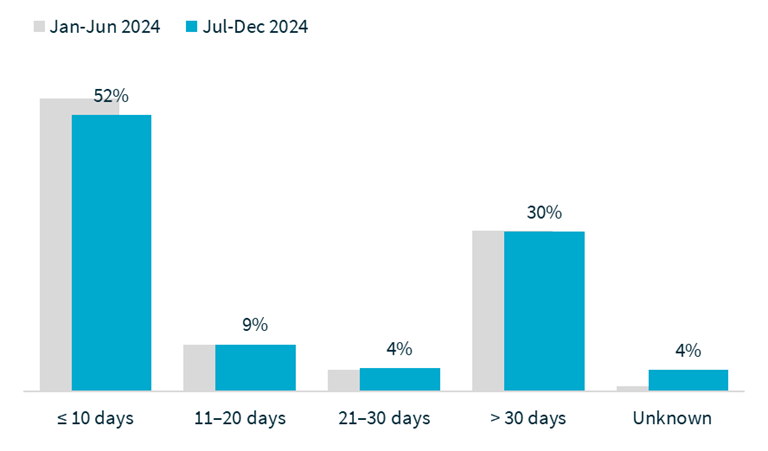
Chart 11 – Time taken to identify breaches by source of breach
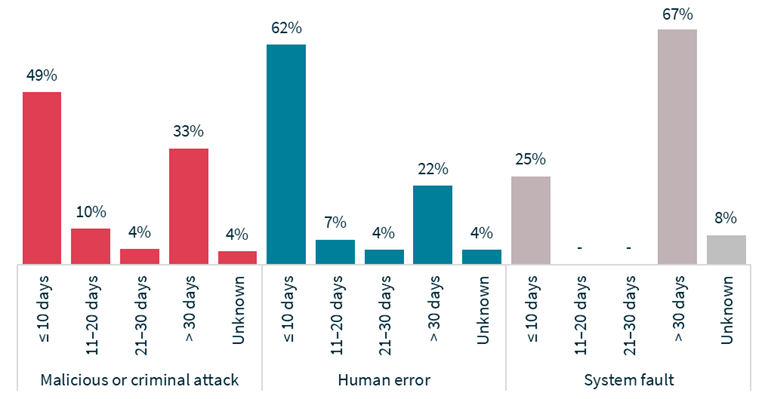
Time taken to notify the OAIC of breaches
The figures in this section relate to the time between when an entity became aware of an incident and when they notified the OAIC. They do not relate to the time between when the entity determined the incident to be an eligible data breach and when they notified the OAIC.
Chart 12 – Time taken to notify the OAIC of breaches
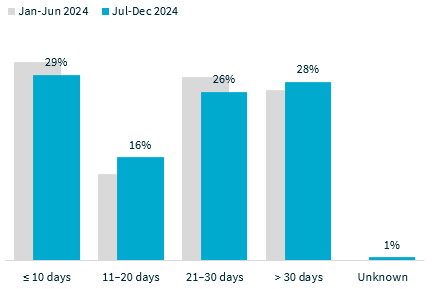
Chart 13 – Time taken to notify the OAIC of breaches by source of breach
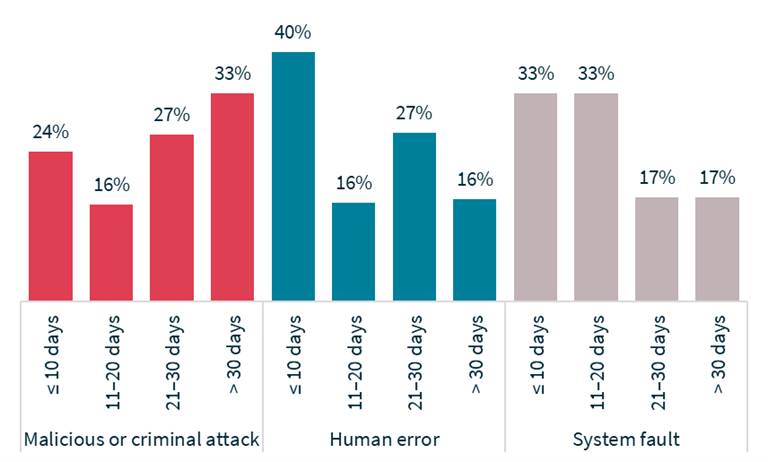
Comparison of top 5 sectors
Sector | Number of notifications | Percentage of all notifications received |
|---|---|---|
Health service providers | 121 | 20% |
Australian Government | 100 | 17% |
Finance (incl. superannuation) | 54 | 9% |
Legal, accounting and management services | 36 | 6% |
Retail | 34 | 6% |
Total | 345 | 58% |
A health service provider generally includes any private sector entity that provides a health service within the meaning of s 6FB of the Privacy Act 1988, regardless of annual turnover.
The finance sector includes banks, wealth managers, financial advisors, superannuation funds, and consumer credit providers (regardless of annual turnover).
Chart 14 – Source of breaches – Top 5 sectors
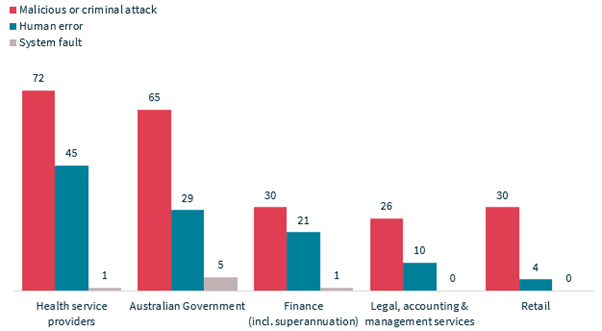
For notifications in the ‘unknown’ category, the entity was unable to identify the date the breach occurred.
For notifications in the ‘unknown’ category, the entity was unable to advise the OAIC the date it became aware of the incident.
Chart 15 – Source of breaches – Top 5 sectors
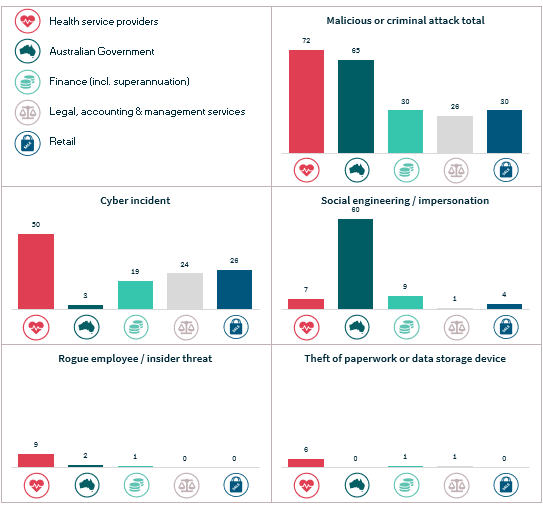
Chart 16 – Cyber incident breakdown – Top 5 sectors
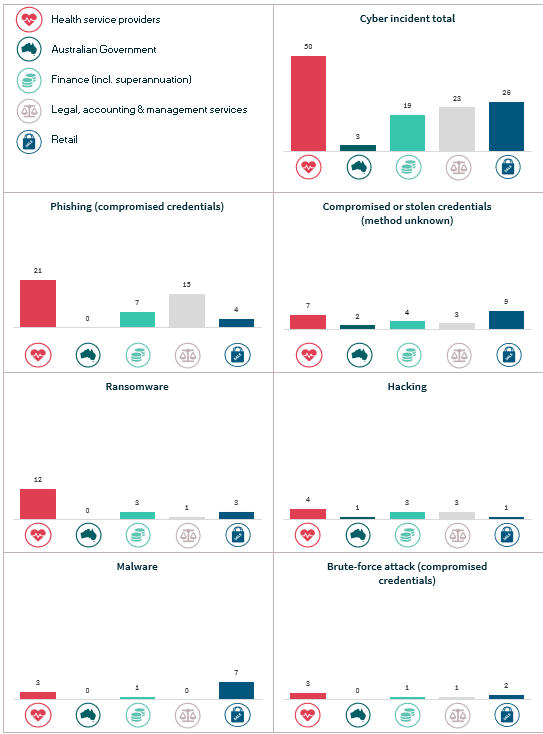
Chart 17 – Human error breakdown – Top 5 sectors
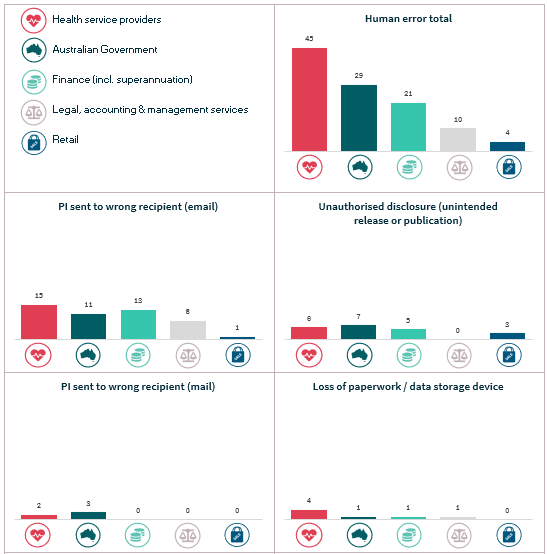
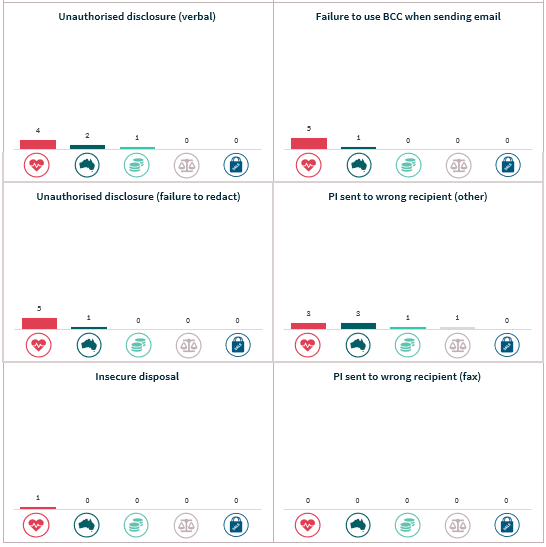
Chart 18 – System fault breakdown – Top 5 sectors
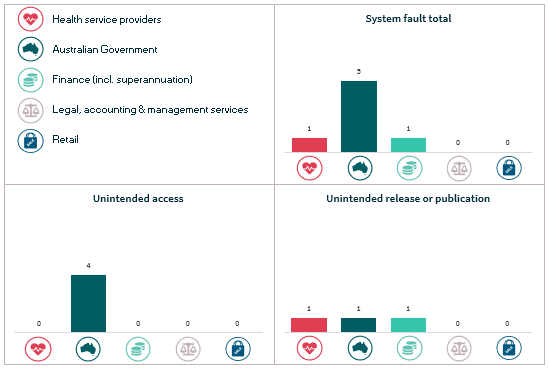
Chart 19 – Time taken to identify breaches – Top 5 sectors
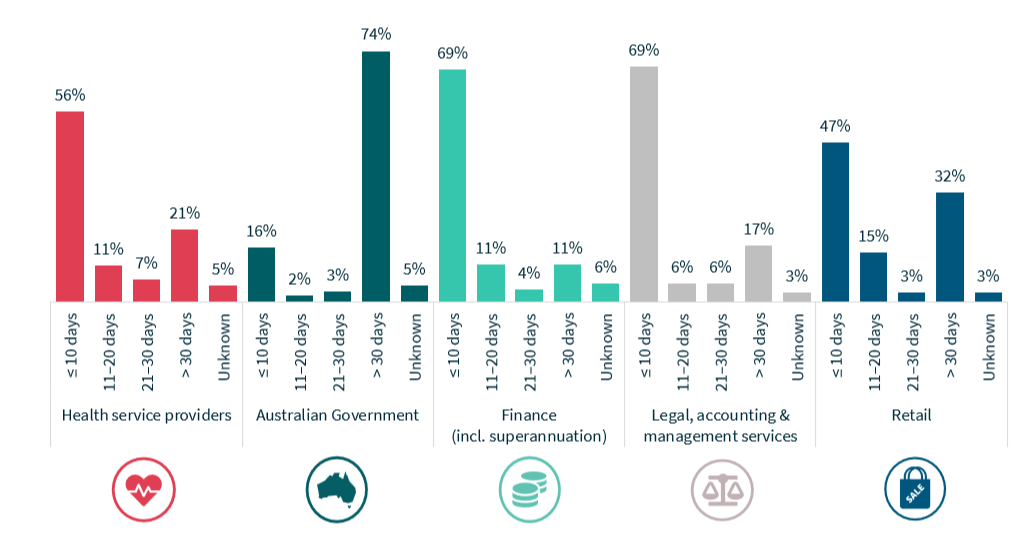
For notifications in the ‘unknown’ category, the entity was unable to identify the date the breach occurred.
Chart 20 – Time taken to notify breaches – Top 5 sectors
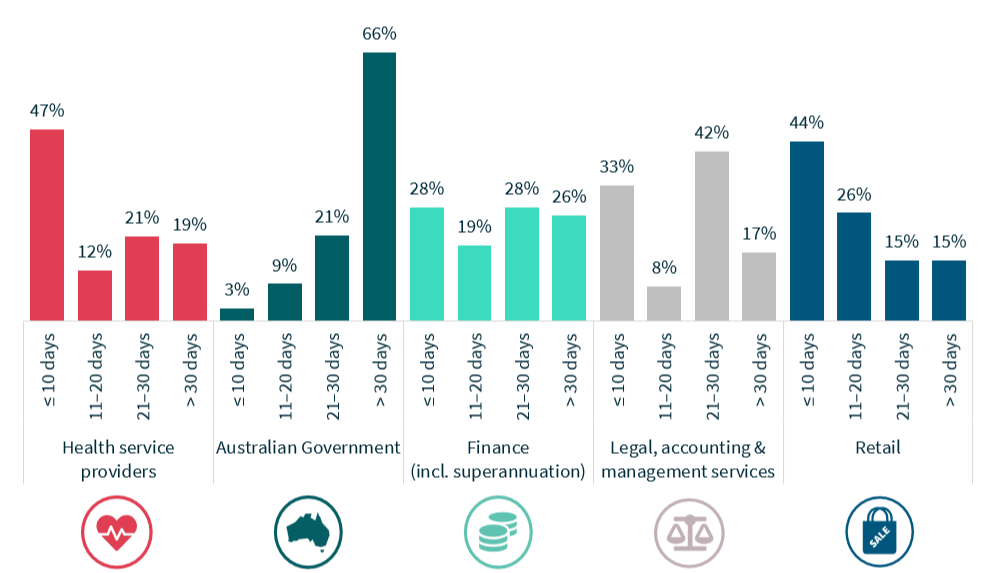
For notifications in the ‘unknown’ category, the entity was unable to advise the OAIC the date it became aware of the incident.
Glossary
Term | Definition |
|---|---|
Contact information | Information that is used to contact an individual, for example, a home address, phone number or email address |
Eligible data breach | An eligible data breach occurs when:
|
Financial details | Information relating to an individual’s finances, for example, bank account or credit card numbers |
Health information | As defined in s 6 of the Privacy Act 1988 (Cth) |
Identity information | Information that is used to confirm an individual’s identity, such as a passport number, driver licence number or other government identifier |
Other sensitive information | Sensitive information, other than health information, as defined in s 6 of the Privacy Act, for example, sexual orientation, political or religious views |
Personal information (PI) | Information or an opinion about an identified individual or an individual who is reasonably identifiable |
Sensitive information | Sensitive information is personal information that includes information or an opinion about an individual’s:
|
Tax file number | An individual’s personal reference number in the tax and superannuation systems, issued by the Australian Taxation Office |
Human error | An unintended action by an individual directly resulting in a data breach, for example, inadvertent disclosure caused by sending a document containing personal information to the incorrect recipient |
Failure to use BCC when sending email | Sending an email to a group by including all recipient emails addresses in the ‘To’ field, thereby disclosing all recipient email addresses to all recipients |
Insecure disposal | Disposing of personal information in a manner that could lead to its unauthorised disclosure, for example, using a public rubbish bin to dispose of customer records instead of a secure document disposal bin |
Loss of paperwork/data storage device | Loss of a physical asset containing personal information, for example, leaving a folder or a laptop on a bus |
PI sent to wrong recipient (email) | Personal information sent to the wrong recipient via email, for example, as a result of a misaddressed email or having a wrong address on file |
PI sent to wrong recipient (fax) | Personal information sent to the wrong recipient via facsimile machine, for example, as a result of an incorrectly entered fax number or having a wrong fax number on file |
PI sent to wrong recipient (mail) | Personal information sent to the wrong recipient via postal mail, for example, as a result of a transcribing error or having a wrong address on file |
PI sent to wrong recipient (other) | Personal information sent to the wrong recipient via channels other than email, fax or mail, for example, delivery by hand or uploading to web portal |
Unauthorised disclosure (failure to redact) | Failure to effectively remove or de-identify personal information from a record before disclosing it |
Unauthorised disclosure (unintended release or publication) | Unauthorised disclosure of personal information in a written format, including paper documents or online |
Unauthorised disclosure (verbal) | Disclosing personal information verbally without authorisation, for example, calling it out in a waiting room |
Malicious or criminal attack | A malicious or criminal attack deliberately crafted to exploit known vulnerabilities for financial or other gain |
Brute-force attack (compromised credentials) | A typically unsophisticated and exhaustive process to determine a cryptographic key or password that proceeds by systematically trying all alternatives until it discovers the correct one |
Compromised or stolen credentials (method unknown) | Credentials are compromised or stolen by methods unknown |
Cyber incident | A cyber incident targets computer information systems, infrastructures, computer networks or personal computer devices |
Hacking (other means) | Unauthorised access to a system or network (other than by way of phishing, brute-force attack or malware), often to exploit a system’s data or manipulate its normal behaviour |
Malware | Short for ‘malicious software’. A software used to gain unauthorised access to computers, steal information and disrupt or disable networks. Types of malware include trojans, viruses and worms |
Ransomware | Malicious software that makes data or systems unusable until the victim makes a payment |
Rogue employee/ | An attack by an employee or insider acting against the interests of their employer or other entity |
Phishing (compromised credentials) | Untargeted, mass messages sent to many people asking for information, encouraging them to open a malicious attachment, or visit a fake website that will ask the user to provide information or download malicious content |
Social engineering/ impersonation | An attack that relies heavily on human interaction to manipulate people into breaking normal security procedures and best practices in order to gain access to systems, networks or physical locations |
Theft of paperwork or data storage device | Theft of paperwork or data storage device |
System fault | A business or technology process error not caused by direct human error |

